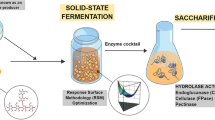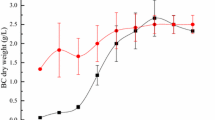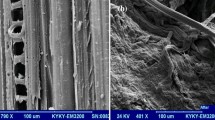Abstract
Schizophyllan is a homoglucan produced by the fungus Schizophyllum commune, with a β-1,3-linked backbone and β-1,6-linked side chains of single glucose units at every other residue. Schizophyllan is commercially produced for pharmaceutical and cosmetics uses. However, the unique physical properties of schizophyllan suggest that it may have biomaterials applications. Schizophyllan is conventionally produced by submerged culture fermentation using glucose as a carbon source. This study demonstrates for the first time the efficient utilization of agricultural biomass substrates, particularly distiller’s dried grains with solubles, for schizophyllan production. Sugar composition analysis, NMR, and permethylation linkage analysis confirmed that the recovered product was schizophyllan. Schizophyllan produced from agricultural residues was of a high molecular weight and exhibited solution viscosity properties similar to those of commercially produced material. Utilization of biomass substrates could reduce the cost of schizophyllan production and provide a new value-added bioproduct for integrated biorefineries of the future.




Similar content being viewed by others
References
Anonymous (1998) Difco Manual, 11th edn. Difco Laboratories, Sparks
Anonymous (2011) Fungus could boost crude output by 45 %. Petrol. Econ. June 2011, General OneFile, Web, 20 June 2012
Biely P, MacKenzie CR, Schneider H (1988) Production of acetyl xylan esterase by Trichoderma reesei and Schizophyllum commune. Can J Microbiol 34:767–772
Desrochers M, Jurasek L, Paice MG (1981) Production of cellulase, β-glucosidase, and xylanase by Schizophyllum commune grown on a cellulose-peptone medium. In: Underkofler LA, Wulf ML (eds) Developments in industrial microbiology, vol 22. Society for Industrial Microbiology, Arlington, pp 675–684
Dunlap CA, Schisler DA, Price NP, Vaughn SF (2011) Cyclic lipopeptide profile of three Bacillus subtilis strains; antagonists of Fusarium head blight. J Microbiol 49:603–609
Gao L, Zhou S (2008) Optimization of extraction technology of schizophyllan produced by solid fermentation. Shipin Gongye Keji 29:214–216
Hakamori S (1964) A rapid permethylation of glycolipid, and polysaccharide catalyzed by methylsulfinyl carbanion in dimethyl sulfoxide. J Biochem Tokyo 55:205–208
Johnson LA, May JB (2003) Wet milling: the basis for corn biorefineries 2nd Edition. In: White PJ, Johnson LA (eds) Corn: chemistry and technology. American Association of Cereal Chemists, St. Paul, pp 449–494
Kim Y-T, Kim E-H, Cheong C, Williams DL, Kim C-W, Lim S-T (2000) Structural characterization of β-D-(1→3, 1→6)-linked glucans using NMR spectroscopy. Carbohydr Res 328:331–341
Kumari M, Survase SA, Singhal RS (2008) Production of schizophyllan using Schizophyllum commune NRCM. Biores Technol 99:1036–1043
Leathers TD, Gupta SC (1996) Saccharification of corn fiber using enzymes from Aureobasidium sp. strain NRRL Y-2311-1. Appl Biochem Biotechnol 59:337–347
Leathers TD, Nunnally MS, Cote GL (2010) Optimization of process conditions for enzymatic modification of alternan using dextranase from Chaetomium erraticum. Carbohydr Pol 81:732–736
Leathers TD, Nunnally MS, Price NPJ (2006) Co-production of schizophyllan and arabinoxylan from corn fiber. Biotechnol Lett 28:623–626
Leathers TD, Price NPJ (2007) Effect of oil extraction method on enzymatic digestibility of corn germ arabinoxylan. Cereal Chem 84:243–245
Loy DD, Wright KN (2003) Nutritional properties and feeding value of corn and its by-products. In: White PJ, Johnson LA (eds) Corn: chemistry and technology, 2nd edn. American Association of Cereal Chemists, St. Paul, pp 571–603
Lusas EW (2004) Soybean processing and utilization. In: Boerma HR, Specht E (eds) Soybeans: improvement, production, and uses, 3rd edn. American Society of Agronomy, Madison, pp 949–1046
Price NPJ (2004) Acylic sugar derivatives for GC/MS analysis of 13C-enrichment during carbohydrate metabolism. Anal Chem 76:6566–6574
Rau U (1999) Production of schizophyllan. In: Bucke C (ed) Methods in biotechnology, carbohydrate biotechnology protocols, vol 10. Humana Press, Totowa, pp 43–55
Rau U (2002) Schizophyllan. In: Vandamme EJ, De Baets S, Steinbuchel A (eds) Biopolymers polysaccharides II: polysaccharides from eukaryotes, vol 6. Wiley-VCH, Weinheim, pp 61–91
Rosentrater KA, Ileleji K, Johnston DB (2012) Manufacturing of fuel ethanol and distillers grains: current and evolving processes. In: Liu K, Rosentrater KA (eds) Distillers grains: production, properties, and utilization. CRC Press, Boca Raton, pp 73–102
Schulz D, Rau U, Wagner F (1992) Characteristics of films prepared from native and modified branched β-1,3-D-glucans. Carbohydr Pol 18:295–299
Shu C, Hsu H (2011) Production of schizophyllan glucan by Schizophyllum commune ATCC 38548 from detoxificated hydrolysate of rice hull. J Taiwan Inst Chem Eng 42:387–393
Steiner W, Lafferty RM, Gomes I, Esterbauer H (1987) Studies on a wild strain of Schizophyllum commune: cellulase and xylanase production and formation of the extracellular polysaccharide schizophyllan. Biotechnol Bioeng 30:169–178
Acknowledgments
Expert technical assistance was provided by Erika Hertenstein, Suzanne Unser, Trina Hartman, Karl E. Vermillion, and Andrew J. Thomas. The authors sincerely thank Christopher Dunlap for surface tension measurements. This project was supported by Agriculture and Food Research Initiative Competitive Grant no. 2010-65504-20377 from the USDA National Institute of Food and Agriculture.
Author information
Authors and Affiliations
Corresponding author
Additional information
Mention of any trade names or commercial products in this publication is solely for the purpose of providing specific information and does not imply recommendation or endorsement by the U.S. Department of Agriculture. USDA is an equal opportunity provider and employer.
Rights and permissions
About this article
Cite this article
Sutivisedsak, N., Leathers, T.D., Nunnally, M.S. et al. Utilization of agricultural biomass in the production of the biopolymer schizophyllan. J Ind Microbiol Biotechnol 40, 105–112 (2013). https://doi.org/10.1007/s10295-012-1208-8
Received:
Accepted:
Published:
Issue Date:
DOI: https://doi.org/10.1007/s10295-012-1208-8




